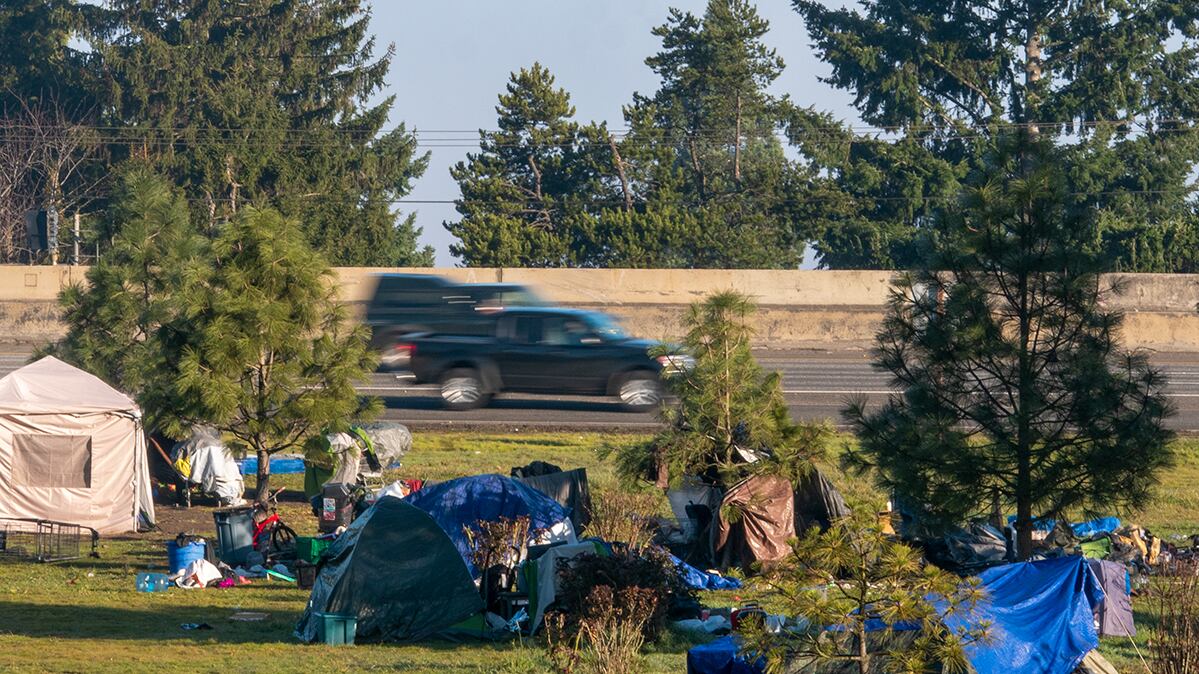Last week, Portland Mayor Ted Wheeler viewed two staggering numbers.
The first, enclosed in a Portland Bureau of Transportation report on traffic deaths, was 19. That’s the number of homeless people killed by cars while on foot in 2021—70% of the 27 pedestrian deaths in the city. That statistic confirmed what advocates had warned for months: The city’s housing crisis was placing vulnerable people in the paths of cars.
The second number was a poll result. A December survey of voters, commissioned by the city’s most powerful business association, the Portland Business Alliance, showed 79% of Portlanders supported requiring people sleeping on the streets to move to a shelter or sanctioned camping area. That’s the kind of voter support usually reserved for public libraries.
Together, the two numbers gave Wheeler fresh motivation to enact an idea he had started discussing last fall: sweeping campers living along highway shoulders and the city’s busiest surface streets. Those roads, called “high-crash corridors,” make up 8% of the city’s street network.
Wheeler acted swiftly. The camping ban along busy roadways went into effect Feb. 5 via an emergency order. Observers of City Hall say it’s the strongest indication in a year that the mayor feels the dismay growing among constituents regarding Portland’s homelessness crisis.
Wheeler said Friday the poll numbers did not change his timing, but “underscore the urgency of the issue and the anger and frustration that our constituents have about the lack of action.”
He’s reopened a fierce debate about safety, livability and the ethics of sweeps in the city’s neighborhoods—one that has rarely left anyone satisfied. And conversations with eight observers close to the issue show Wheeler’s plan may have a pivotal political impact as well as a practical one.
Here are three keys to understanding what Wheeler’s order means.
Many of the most dangerous streets in the city are also shopping districts.
A quarter of the high-crash corridors where Wheeler banned camping are also home to the city’s business districts. The corridors include Southeast Hawthorne Boulevard, Burnside Street and Northeast Fremont Street—all shopping destinations where business owners complain that tent camping has slowed commerce.
Sam Adams, a top aide to Wheeler, says the ban was initially to apply only to highways owned by the Oregon Department of Transportation—only on Wednesday were PBOT corridors added. Deaths along PBOT roads decreased slightly the past two years, from 33 to 31 in 2021. Deaths along ODOT roads have doubled since 2019, from 16 to 32.
Ashton Simpson, co-founder of the advocacy group Oregon Walks, publicly called for the city to move campers from alongside freeways earlier this year. But he’s outraged that the mayor’s ban doesn’t promise to relocate campers to safer locations. He says that points to the real winners from last week’s announcement.
“One small section will benefit: the business owners,” says Simpson, who adds he doesn’t want to presume Wheeler’s motivations behind the ban. “I’ll let the map speak for itself.”
Adams says the policy was not informed by business interests. The decision was purely “evidence-based”—on the Transportation Bureau’s map of where crashes occur most often.
“Some business districts happen to be covered by this, and a lot are not,” Adams says.
Indeed, the president and CEO of the Portland Business Alliance says he wasn’t consulted until 48 hours before the announcement. But he supports the ban, calling it “common sense.”
“It’s possible that this will be welcome news for storefront retailers and employers in certain areas of the city, but we first need to see the implementation details,” Andrew Hoan says. “We would hope that every one of our elected officials, including the mayor, would be motivated to help employers, especially main street retailers, thrive.”
Several months ago, new political advocacy group People for Portland began threatening legal action against the city for the presence of trash along roads and highways.
In the group’s solicitation of complaints about trash that it says it’ll use in potential legal action, the group lists specific roadways that bother it the most: Interstates 5, 84 and 205 and Powell, Sandy and Columbia boulevards, among others.
Eight of the 10 freeways and major thoroughfares the group lists as most cluttered with trash will be part of the mayor’s ban on camping. Wheeler’s office insists his ban “is based on what is the healthiest and safest option” for homeless Portlanders.
The city already had the authority to keep people from camping along busy streets.
So far, the details provided by the mayor’s office and the Office of Management and Finance are scant about how the policy will be enforced. Wheeler said Friday that “for the most part, when asked to leave, people will move.”
While it’s true that few campers resist moving when swept, they often return within days to the same spot. Wheeler promises that such camps will receive first priority to keep people from resettling there—but he hasn’t explained how. (Wheeler says he would support fencing off freeway shoulders, but that’s up to ODOT.)
The city prioritizes camps for removal based on several criteria—including proximity to a park or school, the size of the camp, and reports of crime. A complaint must be made through an online portal for a camp to be considered.
OMF provided few clarifying details to WW about how some roadside camps would be cleared more quickly than others.
“Camps located in high-traffic areas are already high on the list, so those by on- and off-ramps and freeways are a big focus,” says Mark Alejos, a spokesman for the office. “If someone returns, the program will work with that person to have them move. If the person stays, and/or more return, the camp will continue to be posted for removal until there are no returns.”
That is a change: Campers who return to swept roadsides will move to the top of the city’s priority list. Alejos says the city will team “with the public,…ODOT and PBOT to identify specific locations of concern.” (PBOT says it’s been provided “no details” how that will work.)
But the city portal already gets around 1,000 complaints a week. The city recently beefed up its cleanup teams from nine to 18 members, but it’s unclear whether specific teams will be dedicated to enforcing the ban.
The ban places two sitting commissioners in a tough spot.
How the two city commissioners up for reelection this May—Jo Ann Hardesty and Dan Ryan—respond to the mayor’s ban could be pivotal to their flagging bids to keep their seats.
Hardesty expressed disappointment last week that she first heard about the ban from media reports, and that PBOT, which she oversees, was not briefed on the decision. (Wheeler disagrees: He said last week commissioners “were certainly aware” of the impending order.)
It makes sense that Hardesty would be frustrated: Wheeler, her longtime frenemy on the City Council, has placed her in a spot where her traditional opposition to camp sweeps flies in the face of the public mood.
The PBA’s poll that showed homelessness was a higher priority for Portlanders than any other issue also found 54% of voters said they would not vote for Hardesty. That means she’ll have to persuade undecided voters she’s right to oppose the mayor on the single issue that frustrates voters most.
She tried to strike a balance in her response.
“While an urgent response is needed, the mayor’s unilateral action has me concerned these policies lack important details while ignoring the expertise of our houseless community, their advocates, and the devoted street safety experts at PBOT,” Hardesty tells WW.
For Ryan, who has a higher number of undecided voters he could sway to his side, the issue is simpler: He supports the mayor’s ban. He just has to hope it works.
“Removing people living unprotected next to high-crash corridors is necessary to save lives,” Ryan tells WW. “Now [we] need to partner with Multnomah County…to increase our shelter capacity so that we can safely enact the declaration.”
But shelter capacity lags. None of the city’s safe rest villages are open yet. The city and county set aside funding last fall to make available 100 beds in existing shelters for people displaced by sweeps; Wheeler said last Friday the beds would be prioritized for people displaced by his emergency order.
But it’s likely to be weeks before the beds are made available at existing shelters, according to the Joint Office of Homeless Services.

